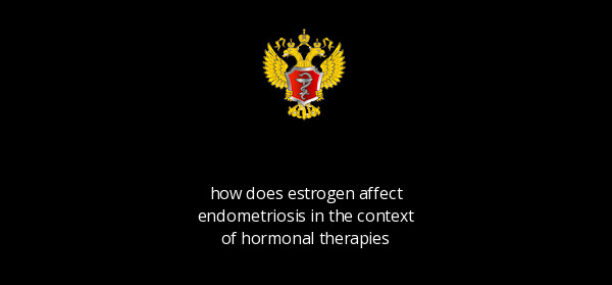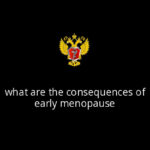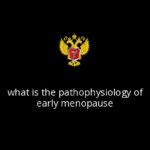Abstract
While estrogen deficiency may alleviate symptoms of endometriosis, the use of estrogen-containing therapies such as HRT requires careful consideration and monitoring in women with a history of the disease. Healthcare providers should assess the risks and benefits of hormonal treatments on an individual basis, taking into account the severity of symptoms, disease activity, reproductive goals, and potential complications associated with estrogen exposure. Close surveillance and proactive management are essential for optimizing outcomes and reducing the risk of adverse events in this patient population
How does estrogen affect endometriosis in the context of hormonal therapies?
While estrogen deficiency can lead to a reduction in the size and activity of endometriotic implants, the use of exogenous estrogen, such as in HRT, can potentially exacerbate the condition and increase the risk of complications.
Early menopause can often mask underlying gynecological conditions such as endometriosis, as the absence of regular menstrual cycles may obscure the typical symptoms associated with the disorder. Endometriosis can manifest with a wide range of symptoms, including pelvic pain, dysmenorrhea (painful menstruation), dyspareunia (pain during intercourse), and infertility, among others. However, in women experiencing early menopause, these symptoms may not be as readily apparent or may be attributed to menopausal changes.
The lack of menstrual cycles in early menopause can delay the diagnosis of endometriosis, as the hallmark symptom of cyclic pelvic pain may be absent. Additionally, hormonal fluctuations associated with menopause can alter the presentation of endometriosis symptoms, leading to variability in clinical manifestations and potentially complicating the diagnostic process.
Healthcare providers should maintain a high index of suspicion for endometriosis in women with early menopause, especially those presenting with pelvic pain, infertility, or other gynecological symptoms. A thorough medical history, physical examination, and imaging studies (such as ultrasound or MRI) may aid in the detection of endometriotic lesions and the evaluation of pelvic anatomy.
Diagnostic laparoscopy remains the gold standard for confirming the diagnosis of endometriosis, allowing for direct visualization and biopsy of endometriotic implants. However, given the challenges of diagnosing endometriosis in women with early menopause, a multidisciplinary approach involving gynecologists, reproductive endocrinologists, and imaging specialists may be necessary to ensure timely and accurate diagnosis and appropriate management.
Early recognition and treatment of endometriosis in women with early menopause are crucial for addressing symptoms, preserving fertility (if desired), and optimizing overall gynecological health. By raising awareness of the potential overlap between early menopause and endometriosis and promoting proactive evaluation and management strategies, healthcare providers can better support women in navigating the complexities of these interconnected reproductive health issues
Here’s a closer look at the relationship between estrogen exposure, endometriosis, and associated risks:
Impact of Estrogen on Endometriosis:
Endometriosis is an estrogen-dependent condition, meaning that estrogen promotes the growth, proliferation, and inflammation of endometriotic lesions.
Estrogen receptors present on endometriotic implants allow them to respond to circulating estrogen, stimulating their growth and contributing to the persistence of the disease.
High levels of estrogen, whether endogenous (produced by the ovaries) or exogenous (from HRT), can exacerbate endometriosis symptoms and lead to the development of complications such as pelvic pain, adhesions, and ovarian cysts.
Hormone Replacement Therapy (HRT) and Endometriosis:
Hormone replacement therapy (HRT) is commonly prescribed to manage menopausal symptoms by supplementing declining estrogen levels.
However, the use of estrogen-containing HRT in women with endometriosis requires careful consideration due to the potential risk of disease recurrence or progression.
Estrogen supplementation in HRT can stimulate the growth of residual endometriotic implants, leading to symptom exacerbation, recurrence of pelvic pain, and the development of new lesions.
Additionally, estrogen therapy may increase the risk of complications such as ovarian cysts, adenomyosis, and endometriosis-related infertility in women with a history of the disease.
Risk of Malignancy and Complications:
Prolonged exposure to high levels of estrogen, whether from endogenous or exogenous sources, may increase the risk of endometriosis-associated malignancies, such as endometrioid and clear cell ovarian cancers.
Estrogen-driven proliferation of endometriotic implants can lead to the accumulation of genetic mutations, DNA damage, and alterations in cellular signaling pathways, contributing to malignant transformation over time.
Women with endometriosis, particularly those undergoing long-term HRT, should be monitored closely for signs of disease progression, ovarian cysts, and potential malignancies through regular pelvic examinations, imaging studies, and tumor marker assessments.
When estrogen receptors are found outside the uterus, particularly in the context of endometriosis, it signifies a condition where endometrial-like tissue grows outside the uterine cavity. This condition, known as extrapelvic or extrauterine endometriosis, occurs when endometrial tissue implants onto other organs or structures within the pelvic or abdominal cavity. Here’s a detailed description of this condition:
Endometriosis Overview:
Endometriosis is a chronic gynecological disorder characterized by the presence of endometrial-like tissue (endometriotic implants) outside the uterus.
These implants may be found on pelvic organs such as the ovaries, fallopian tubes, uterosacral ligaments, and pelvic peritoneum, as well as on extrapelvic sites including the intestines, bladder, diaphragm, and surgical scars.
The exact cause of endometriosis is not fully understood, but it is believed to involve a combination of genetic, hormonal, immunological, and environmental factors.
Estrogen Receptors in Endometriosis:
Endometriotic implants are often responsive to estrogen, as they contain estrogen receptors that facilitate their growth and proliferation.
Estrogen receptors (ERα and ERβ) are present in both eutopic (normal) and ectopic (abnormal) endometrial tissue, allowing estrogen to stimulate cell proliferation, inflammation, and angiogenesis within the endometriotic lesions.
Impact of Extrapelvic Endometriosis:
Extrapelvic endometriosis refers to the presence of endometriotic implants in sites outside the pelvic cavity, such as the gastrointestinal tract, urinary system, respiratory system, and other distant locations.
Endometriotic lesions in extrapelvic locations may cause a variety of symptoms and complications depending on their size, location, and proximity to vital organs or structures.
Symptoms of extrapelvic endometriosis may include abdominal pain, gastrointestinal disturbances (e.g., diarrhea, constipation, bloating), urinary symptoms (e.g., dysuria, hematuria), thoracic symptoms (e.g., chest pain, dyspnea), and infertility.
Association with Early Menopause:
There is a significant overlap between endometriosis and early menopause, as both conditions can affect women of reproductive age and share common risk factors such as genetic predisposition, hormonal dysregulation, and inflammation.
The presence of endometriosis, particularly severe or advanced disease, may contribute to ovarian dysfunction, premature ovarian insufficiency (POI), or early menopause in affected individuals.
Chronic inflammation, oxidative stress, and hormonal disturbances associated with endometriosis may accelerate ovarian aging and follicular depletion, leading to the premature cessation of ovarian function and onset of menopausal symptoms.
When estrogen receptors are distributed beyond the uterus in the context of endometriosis, it signifies the presence of endometrial-like tissue in extrapelvic locations, which may contribute to a range of symptoms and complications, including early menopause. Understanding the complex interplay between endometriosis, estrogen signaling, and ovarian function is essential for effectively managing the condition and its associated gynecological and reproductive health concerns
Verified by: Dr.Diab (March 29, 2024)
Citation: Dr.Diab. (March 29, 2024). how does estrogen affect endometriosis in the context of hormonal therapies. Medcoi Journal of Medicine, 3(2). urn:medcoi:article32657.














There are no comments yet
Or use one of these social networks